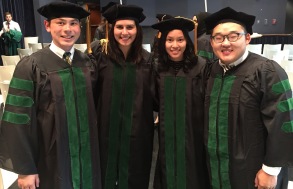Author: Linda Katirji, MD, EM Resident, University of Kentucky Emergency Medicine, on behalf of the CORD Student Advising Taskforce

Over the past several years the members of the CORD Student Advising Task Force (SATF) have been working to provide a set of resources for students applying to Emergency Medicine and those who advise them. Last year SATF released a comprehensive Emergency Medicine Applying Guide, a collection of Frequently Asked Questions, and a student planner. These guides are intended to address common scenarios and questions that most students applying to EM residency will have.
The purpose of this post is to provide specific recommendations for students in circumstances where the usual advice is not enough. These individual student population guides were created based on the collective wisdom and best advising practices of the members of SATF and on the best available data. The specific populations addressed are the re-applicant, the osteopathic student, the international medical graduate, students applying in the couples match, the at-risk applicant, and the military student. Below, find the key points for each population as well as a link to the full document.
Advising the At Risk Applicant
This applying guide is intended for students interested in applying to Emergency Medicine (EM) but who have had academic struggles, professionalism concerns, or other potential “red flags” that may affect his or her ability to match. It was created by Liza Smith, MD, Emily Hillman, MD, Jamie Hess, MD, Seth Kelly, Katelyn Harris, MD, and Adam Kellogg, MD. Below are their key points:
Key Points
What does it mean to have “Red Flags” in your application?
“Red Flags” refer to signs in an application that raise concerns about an applicant. They tend to fall into one of three categories:
- Academic struggle (such as failing the USMLE or repeating a preclinical course or year)
- Professionalism concerns (such as academic misconduct or having a misdemeanor/felony history)
- Unexplained gaps on your CV
How should I address a “Red Flag”?
It may be tempting to hope it will go unnoticed by all of the experienced reviewers who will be looking at your application. You are almost invariably better off using your personal statement as a vehicle to address any “Red Flag” and explain what you have learned and how you have grown from the associated experience.
Full document here.
Advising the Osteopathic Student
This applying guide was written by Liza Smith MD, Zach Jarou MD, Lucienne Lutfy-Clayton MD, Emily Hillman MD, Elizabeth Karr, DO, Ross Christensen, Adam Kellogg MD, and Megan Stobart-Gallagher, DO. It is intended for the osteopathic medical student seeking to pursue a successful match in the ACGME system. Here are their key recommendations:
Key Points
- Taking the USMLE Step 1 and Step 2 will allow your knowledge base to be compared apples to apples with your allopathic peers. A USMLE Step 1 score <220 warrants taking Step 2 CK early as well as a back-up plan.
- Try to complete two audition electives at allopathic residency-based training programs before October of your fourth year.
- Aim to get 2 Standard Letter of Evaluations (SLOEs) from ACGME EM programs submitted as early as possible, ideally before ERAS opens on September 15th.
- Be strategic with your application: do some legwork to identify programs that are open to interviewing and matching osteopathic candidates.
- Find an advisor familiar with the EM application process to discuss your application, help gauge your competitiveness, and come up with a back-up plan if needed.
Full document here.
Advising the International Medical Graduate

This applying guide is for those who are international medical graduates applying to ACGME-accredited Emergency Medicine programs. It was created by Xiao C. Zhang, MD, MS, Zach Jarou MD, Adam Kellogg, MD, Lucienne Lutfy-Clayton, MD, Mary Ann Edens, MD, FACEP, Adam Kenney, MD and Emily Hillman, MD. Here are their key recommendations:
Key Points
- Why are IMG applicants at a disadvantage?
EM program directors are not likely to be familiar with the myriad of international medical schools and therefore consider IMG applicants higher academic risks. As a result, IMG students need to demonstrate objective mastery of the medical arts via top grades, strong letters of recommendation (at least one SLOE), above average USMLE scores, and a robust CV.
2. Are there financial implications to hiring an IMG resident?
Unfortunately, yes. Some medical institutions only sponsor certain types of visas, and for others, the department is be responsible for funding. It is difficult for a PD justify spending money to match an IMG applicant when they can match an equally qualified U.S. graduate for free
3. What is one major pitfall for IMG applicants?
Spelling and grammatical errors. PD’s are bombarded with thousands of applications from highly qualifying applicants during the interview season. Any simple grammatical mistakes or typo on your application may reflect (possibly inaccurately) your level of English proficiencies and lead to rejection.
Advice: have someone read your application, and then have someone read it again.
What can an IMG applicants do to tip the scale to their favor?
- Find a mentor and advisor to guide you through this challenging, but exciting process.
- Do some research first
- Find out where your senior colleagues applied, rotated, and matched, and ask for their advice.
- Apply (although not exclusively) to programs that have a history of accepting IMG applicants.
- Rotate at an academic program and get an outstanding SLOE.
- Speak/write proper English and make sure your ERAS application is flawless.
- Have an overall strong ERAS application:
-
- Appear special.
- Include your unique services, leadership, and research.
- Don’t forget to mention your particular background. After all, you are going against major odds by applying to an EM residency program as an IMG, so demonstrate to the PDs that you are not afraid of a challenge.
- Make sure you have the right visa for the institution that you are applying to.
- Have an advocate: financial, educational, or emotional (or all three).
Full document here.
Advising Students in the Couples Match
The purpose of this applying guide is to provide some insight into the process of couples matching. This guide is intended applicant pairs where one or both students plan to apply to Emergency Medicine (EM). It was created by Caitlin Schrepel MD, Katie Harter MD, Heather Streich MD, Emily Hillman MD, Adam Kellogg MD. Below are their key points.
Key Points:
- Educate yourself about the process early at: http://www.nrmp.org/match-process/couples-in-the-match/
- Talk with your student advisor about realistic goals for number of applications, interviews and programs to rank for your specific situation.
- Communicate clearly with your partner about your goals and priorities.
The couples match process is different for every couple, so it is important to figure out how it will work best for you. Remember that despite the stress, this system and process is m

eant to help you and your partner!
For more information on NRMP logistics visit: http://www.nrmp.org/match-process/couples-in-the-match/
Full document here.
Advising the Military Student
The purpose of this applying guide is to serve as an overview of the military Emergency Medicine (EM) match process for both students and their advisors. It was created by Linda Katirji MD, Sameer Desai MD, Emily Hillman MD, Lucienne Lufty-Clayton MD, Gillian Schmitz MD, and Kevin King, MD. Below are their key points:

Key Points
The military match is a difficult system to navigate. Many aspects of it can change from year to year and it is different for each branch of the military. It is very important to find a mentor on your own who is knowledgeable about the process to help guide you. The following is a list of a few key points:
- Focus on success during medical school following the same principles outlined in the CORD Student Advising Task Force (SATF) EM Applicant’s Frequently Asked Questions and EM Applying Guide.
- Start preparing early: find a mentor who is knowledgeable about the military match process to guide you. Consider reaching out to the military training programs to learn about timelines specific to their program. (Students may also sign up for a military resident mentor through EMRA. Mentorship application and information is available at https://www.emra.org/students/mentorship)
- Strongly consider an EM rotation at a military hospital in addition to a civilian program, not doing so can negatively impact your application.
- It is imperative that you go through the military match and interview at military programs even if your goal is to match at a non-military program. If you do not interview with the military, you will not be eligible for the civilian match.
- Plan for civilian interviews and, when possible, schedule them for late December or January of your 4th year.
For more detailed information on military EM please follow link below for an expanded FAQ document created by the Government Services Chapter of the American College of Emergency Physicians (GSACEP).
http://associationdatabase.com/aws/GSACE/pt/sp/students
Full document here.
Advising the Re-Applicant
Mary Ann Edens MD, Jeffrey Druck MD, Adam Kellogg MD, and Emily Hillman, MD created this applying guide for those unsuccessful in matching in Emergency Medicine (EM) but not yet willing to give up on training in EM. Here are their key recommendations:
Key Points
- Consider extending medical school or participating in the SOAP to secure a non-EM preliminary or categorical position.
- Whenever possible, strongly consider an EM rotation in the summer or early fall so you can have an updated SLOE.
- Make sure to perform an honest review and assessment of your application with a trusted advisor.
- Address red flags in your application/personal statement.
- Whenever possible, strongly consider an EM rotation in the summer or early fall so you can have an updated SLOE or letter of recommendation.
- If you did a preliminary or categorical year, have your current program director write you a letter of recommendation.
Full document here.
The guides above intend to aid advisors and their students in navigating through the Emergency Medicine residency application. Although each applicant comes with their own set of strengths and weaknesses, the groups above face unique challenges during the application process. Our hope is to provide a set of recommendations and resources to help advisors guide these students to maximize their success.

[…] medical student advising. This led to the creation of the EM Applying Guide as well as multiple addenda for special populations. These guides contain the best practices of the CORD and CDEM (Clerkship Directors in Emergency […]
LikeLike